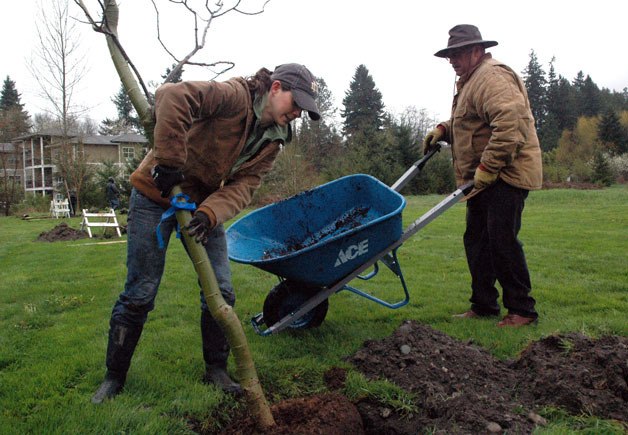ARLINGTON — The pouring rain did little to dampen the spirits of volunteers at Jensen Park on Saturday, April 13, as they planted trees provided by Banksavers, celebrated the city of Arlington’s 11th year of being designated as a “Tree City USA” by the Washington State Department of Natural Resources, and eventually came in from the cold to check out the Stillaguamish Tribe of Indians’ cultural exhibits in the Kent Prairie Elementary gymnasium.
“It’s actually a great day for a tree-planting because the roots will stay firmer if they’re wet,” said city of Arlington Stormwater Manager Bill Blake, as he noted the requirements for a city to be designated a Tree City, including designating staff to care for trees, appointing a citizen tree board to advocate for community forestry, establishing a tree ordinance, spending at least $2 per capita on tree care, and celebrating Arbor Day.
“Sometimes I think we take our trees for granted,” said Arlington Mayor Pro Tem Marilyn Oertle, who was joined on site by fellow City Council member Randy Tendering. “Whenever I come back to Arlington, I’m struck by all the beautiful trees we have, and all the blessings they provide, including serving as homes for birds and other animals. Bill is an excellent manager of our trees, and we’re lucky to have a lot of dedicated people who make things happen.”
Stillaguamish Tribal Chair Shawn Yanity offered a blessing, echoed Oertle’s assessment of the importance of trees as habitat, and urged the younger volunteers in attendance to take the day’s experiences to heart.
“It’s right that we show our appreciation for the gifts that surround us,” Yanity said, before turning to the young people. “It’s up to you to be the next champions to carry this forward because we won’t always be here. This is a testimonial to how much we’re taking ownership of our neighborhoods and taking care of our homelands because a lot of people don’t do that anymore. This park was the site of one of my people’s villages. We’re walking on my ancestral lands here, and the cedar we’re planting was essential to every aspect of our lives.”
Sarah Nelson, education and outreach coordinator for Sound Salmon Solutions, explained how her group coordinated the efforts of the city, the Tribe, Banksavers, the Pilchuck Audubon Society, the Arlington Arts Council, Washington State University Extension’s Puget Sound Forest Stewardship, and their own “Tree Tenders” group to implement the tree-planting, which followed a day of education on the psychological, physiological and cultural benefits of trees on Wednesday, April 10.
“The two workshops and the tree-planting were covered by an urban forestry grant,” Nelson said. “At Pioneer Elementary, students performed an experiment to demonstrate to them how trees protect against erosion. We’re thankful for all of our partners in these projects because in our role as coordinators, we owe these projects’ successes to so many other groups.”
Bill Pierce, a volunteer with Sound Salmon Solutions’ Tree Tenders, pointed out that Jensen Park’s new trees will help provide shade not only for an adjacent salmon-bearing stream, but also the homes bordering the park.
“It’s up to all of us to build the world we want to live in,” said Pierce, who devotes half his time to conservation work now that he’s retired. “A world with trees is a world I want to live in.”
“Cedar was our everything,” said Mercedes MacCurdy, one of the members of the Stillaguamish Tribe who was showing visitors to the Kent Prairie Elementary gym how to weave the wood. “We lived off cedar. We made our homes, our clothes and our crafts from it. This is good medicine.”







